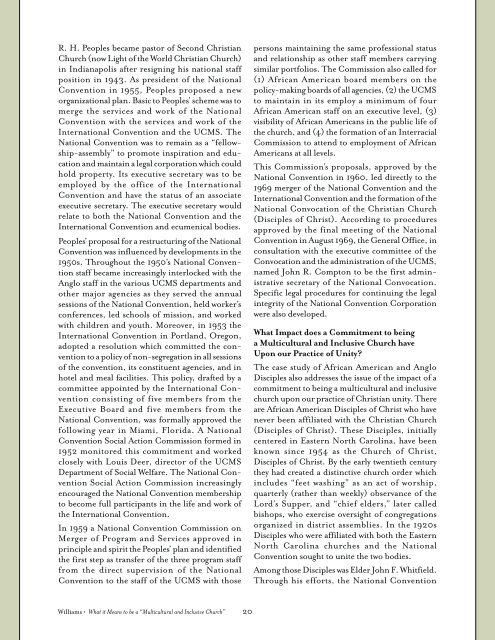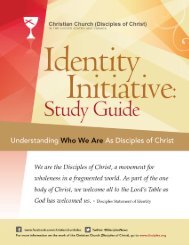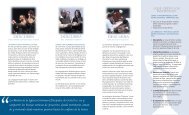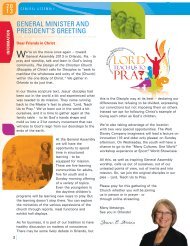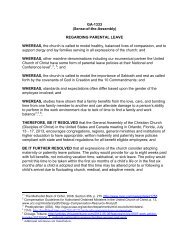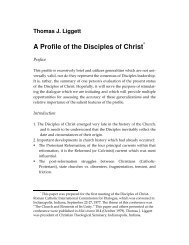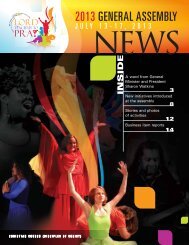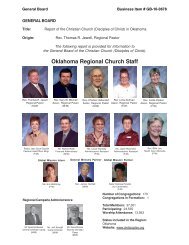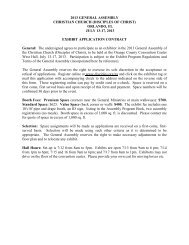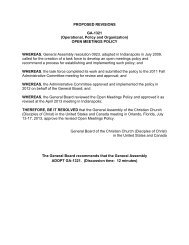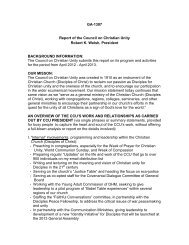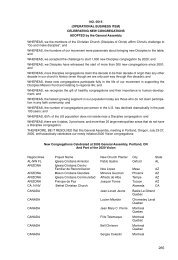RESOURCING THE CHURCH FOR ECUMENICAL MINISTRy A ...
RESOURCING THE CHURCH FOR ECUMENICAL MINISTRy A ...
RESOURCING THE CHURCH FOR ECUMENICAL MINISTRy A ...
Create successful ePaper yourself
Turn your PDF publications into a flip-book with our unique Google optimized e-Paper software.
R. H. Peoples became pastor of Second Christian<br />
Church (now Light of the World Christian Church)<br />
in Indianapolis after resigning his national staff<br />
position in 1943. As president of the National<br />
Convention in 1955, Peoples proposed a new<br />
organizational plan. Basic to Peoples’ scheme was to<br />
merge the services and work of the National<br />
Convention with the services and work of the<br />
International Convention and the UCMS. The<br />
National Convention was to remain as a “fellowship-assembly”<br />
to promote inspiration and education<br />
and maintain a legal corporation which could<br />
hold property. Its executive secretary was to be<br />
employed by the office of the International<br />
Convention and have the status of an associate<br />
executive secretary. The executive secretary would<br />
relate to both the National Convention and the<br />
International Convention and ecumenical bodies.<br />
Peoples’ proposal for a restructuring of the National<br />
Convention was influenced by developments in the<br />
1950s. Throughout the 1950’s National Convention<br />
staff became increasingly interlocked with the<br />
Anglo staff in the various UCMS departments and<br />
other major agencies as they served the annual<br />
sessions of the National Convention, held worker’s<br />
conferences, led schools of mission, and worked<br />
with children and youth. Moreover, in 1953 the<br />
International Convention in Portland, Oregon,<br />
adopted a resolution which committed the convention<br />
to a policy of non-segregation in all sessions<br />
of the convention, its constituent agencies, and in<br />
hotel and meal facilities. This policy, drafted by a<br />
committee appointed by the International Convention<br />
consisting of five members from the<br />
Executive Board and five members from the<br />
National Convention, was formally approved the<br />
following year in Miami, Florida. A National<br />
Convention Social Action Commission formed in<br />
1952 monitored this commitment and worked<br />
closely with Louis Deer, director of the UCMS<br />
Department of Social Welfare. The National Convention<br />
Social Action Commission increasingly<br />
encouraged the National Convention membership<br />
to become full participants in the life and work of<br />
the International Convention.<br />
In 1959 a National Convention Commission on<br />
Merger of Program and Services approved in<br />
principle and spirit the Peoples’ plan and identified<br />
the first step as transfer of the three program staff<br />
from the direct supervision of the National<br />
Convention to the staff of the UCMS with those<br />
Williams • What it Means to be a “Multicultural and Inclusive Church”<br />
20<br />
persons maintaining the same professional status<br />
and relationship as other staff members carrying<br />
similar portfolios. The Commission also called for<br />
(1) African American board members on the<br />
policy-making boards of all agencies, (2) the UCMS<br />
to maintain in its employ a minimum of four<br />
African American staff on an executive level, (3)<br />
visibility of African Americans in the public life of<br />
the church, and (4) the formation of an Interracial<br />
Commission to attend to employment of African<br />
Americans at all levels.<br />
This Commission’s proposals, approved by the<br />
National Convention in 1960, led directly to the<br />
1969 merger of the National Convention and the<br />
International Convention and the formation of the<br />
National Convocation of the Christian Church<br />
(Disciples of Christ). According to procedures<br />
approved by the final meeting of the National<br />
Convention in August 1969, the General Office, in<br />
consultation with the executive committee of the<br />
Convocation and the administration of the UCMS,<br />
named John R. Compton to be the first administrative<br />
secretary of the National Convocation.<br />
Specific legal procedures for continuing the legal<br />
integrity of the National Convention Corporation<br />
were also developed.<br />
What Impact does a Commitment to being<br />
a Multicultural and Inclusive Church have<br />
Upon our Practice of Unity?<br />
The case study of African American and Anglo<br />
Disciples also addresses the issue of the impact of a<br />
commitment to being a multicultural and inclusive<br />
church upon our practice of Christian unity. There<br />
are African American Disciples of Christ who have<br />
never been affiliated with the Christian Church<br />
(Disciples of Christ). These Disciples, initially<br />
centered in Eastern North Carolina, have been<br />
known since 1954 as the Church of Christ,<br />
Disciples of Christ. By the early twentieth century<br />
they had created a distinctive church order which<br />
includes “feet washing” as an act of worship,<br />
quarterly (rather than weekly) observance of the<br />
Lord’s Supper, and “chief elders,” later called<br />
bishops, who exercise oversight of congregations<br />
organized in district assemblies. In the 1920s<br />
Disciples who were affiliated with both the Eastern<br />
North Carolina churches and the National<br />
Convention sought to unite the two bodies.<br />
Among those Disciples was Elder John F. Whitfield.<br />
Through his efforts, the National Convention


